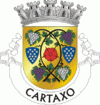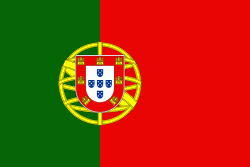Cartaxo Municipality (Cartaxo)
 |
 |
In written and oral history, the territory of Cartaxo was an important point in the interior of the country. A Roman road, crossing Alenquer (Lerabriga), connected ancient Olissipo (Lisbon) to Santarém (Scallabis) through the territory of Cartaxo. Yet, before the Romans, other civilizations settled in the region, establishing castros in Vila Nova de São Pedro, Vale do Tejo or in the areas of Muge. Situated in the plains of the Ribatejo, Cartaxo was a battleground between Muslim and the Christians. Due to its proximity to Santarém, it was one of the centres disputed between Muslim and Christian forces for years, resulting in the destruction of Cartaxo. King Sancho II of Portugal found it necessary to repopulate the area, since it was located in a privileged position with fertile lands. He, therefore, assigned the land of Cartaxinho (today Ribeira do Cartaxo) to Pedro Pacheco, who was responsible for constructing a shelter for the poor, a task that neither Pedro Pacheco nor his descendants would accomplish.
Oral tradition suggests that the name Cartaxo was given to the lands by Queen Elizabeth of Portugal who, on a journey to the Monastery of Almoster, stopped to rest and quench her thirst. Alongside a spring, she was surprised by the beautiful song of an unfamiliar bird. Asking one of the peasants about the songbird, the serf responded that the song came from a bird of the kind called cartaxos or cartaxinhos. Enchanted by the place, the Queen ordered that the land, then called Lugar da Fonte, receive the name Lugar do Cartaxo. It is unclear whether there is any truth to this story.
In 1312, Cartaxo received its first foral (charter), signed in Leiria by King Dinis of Portugal, confirmed in 1487 by King John II (in Santarém), and in 1496 by Manuel (also in Santarém). The first foral, issued by Dinis on 21 March 1312, was sent to his vassal, Garcia Martins, originating the foundation of the locality of Cartaxo. In this act, Dinis exempted the region from taxes for those who grew and cultivated grapes during the first five years of their tenure. Settlers who accepted these land rights were required in return to present each year an eighth of their produce in wine and linen. The historical importance of the municipality is supported by events of the Battle of Ourique, which were probably linked to Vila Chã de Ourique (1139), a concession of foral to Pontével, by King Sancho (1194) and the existence of the Royal Palaces of Valada (1361-1365). In the middle of the 19th century, Cartaxo was one of the more populated areas of Estremadura, in the Comarca of Santarém, with just over 200 inhabitants. On the death of King John IV of Portugal, his testament granted several "honours" to his daughter (in 1656). On 10 December 1815, by royal decree from Rio de Janeiro, King John VI granted it administrative independence, followed up on 21 June 1995 with its elevation to the status of city.
At the end of the 19th century, owing to the growth of technological innovations, Cartaxo became the centre of production of the typical wine of the Valley of the Tejo, much of which was sent by ship to Lisbon.
Map - Cartaxo Municipality (Cartaxo)
Map
Country - Portugal
 |
 |
| Flag of Portugal | |
One of the oldest countries in Europe, its territory has been continuously settled, invaded and fought over since prehistoric times. The territory was first inhabited by pre-Roman and Celtic peoples who had contact with Phoenicians, ancient Greeks and Carthaginians. It was later ruled by the Romans, followed by the invasions of Germanic peoples and the Islamic invasion by the Moors, whose rule was eventually expelled during the Reconquista. Founded first as a county of the Kingdom of León in 868, gained its independence as the Kingdom of Portugal with the Treaty of Zamora in 1143.
Currency / Language
| ISO | Currency | Symbol | Significant figures |
|---|---|---|---|
| EUR | Euro | € | 2 |
| ISO | Language |
|---|---|
| PT | Portuguese language |















